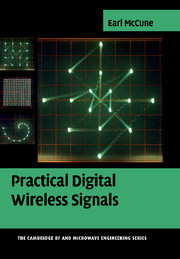Book contents
- Frontmatter
- Contents
- Preface
- Definitions and acronyms
- Terminology and notation
- 1 Keying, states, and block diagram construction
- 2 Common issues and signal characterization
- 3 Important details on results from Shannon, Nyquist, and others
- 4 Digital amplitude modulation (ASK)
- 5 Digital frequency modulation: FSK
- 6 Digital phase modulation: PSK
- 7 Combined digital modulations: QAM and OFDM
- 8 Spread spectrum
- 9 Wireless propagation and antenna fundamentals
- 10 Principles of coding
- 11 Multiple access techniques
- 12 Signal tradeoffs and system evolution
- Tutorial Appendices
- Index
- References
4 - Digital amplitude modulation (ASK)
Published online by Cambridge University Press: 04 August 2010
- Frontmatter
- Contents
- Preface
- Definitions and acronyms
- Terminology and notation
- 1 Keying, states, and block diagram construction
- 2 Common issues and signal characterization
- 3 Important details on results from Shannon, Nyquist, and others
- 4 Digital amplitude modulation (ASK)
- 5 Digital frequency modulation: FSK
- 6 Digital phase modulation: PSK
- 7 Combined digital modulations: QAM and OFDM
- 8 Spread spectrum
- 9 Wireless propagation and antenna fundamentals
- 10 Principles of coding
- 11 Multiple access techniques
- 12 Signal tradeoffs and system evolution
- Tutorial Appendices
- Index
- References
Summary
Signals and characteristics
Of all the DWC signal types, ASK is one of the oldest. ASK is the oldest wireline digital communications signal, because the Morse telegraph was implemented simply as the presence or absence of current on the wire.
The popularity of ASK rises and falls over the decades. This signal type was very popular through the first half of the twentieth century through the use of Morse Code in wireless telegraphy. As commercial interest in greater bandwidth efficiency and power efficiency (see Section 2.8.1) grew through subsequent decades, ASK fell from favor and was replaced by signal types performing far better in these metrics. In more recent decades the need for extreme simplicity and absolute minimum cost in several DWC applications, such as remote keyless entry (RKE), is resulting in a resurgence in the application of ASK.
ASK clearly has its place in the pantheon of DWC signal types. This chapter explores the details of ASK, its advantages and disadvantages, leading to an understanding of where value does exist for this very simple signal type.
Amplitude shift keying definition
For all signals using digital amplitude modulation, the PAM signal (2.3) maps solely onto the amplitude parameter, leaving the frequency and phase parameters constant. One example waveform is shown in Figure 1.4. Mathematically this is written as where .
- Type
- Chapter
- Information
- Practical Digital Wireless Signals , pp. 102 - 123Publisher: Cambridge University PressPrint publication year: 2010



